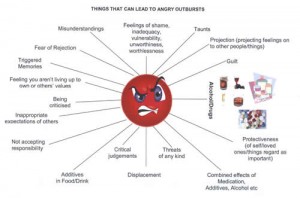Affirmations 
CBT is about challenging negative thoughts, seeking to change them into neutral ones and allowing positive thoughts to follow. Affirmations are a very powerful tool that can be used to help achieve those changes with a great number of challenging issues such as: Anxiety, Depression, Low Self-Esteem, Phobias and OCD. Affirmations are often under-valued and this is probably due to a lack of understanding about how they work and how they can be used to greatest effect. Firstly let’s take a look at how they work.
How Affirmations Work
Consider, for example, somebody who has a lack of self-confidence. He will have, running around his head, all his NATs (negative automatic thoughts) relating to his low levels of self-confidence. The sole purpose of these NATs is to constantly remind, re-affirm and reinforce the feelings surrounding his lack of confidence. This internal voice repeats negative statements to the self, such as “I am no good at talking to people”, “I’m rubbish at learning new skills”, “I can’t get anything right”, etc are all examples of NATs. These subconscious thoughts are very good at consistently reminding the desperately under-confident individual just how useless he is in the confidence stakes, and what is really important is he believes them!
Now let’s take a look at somebody who has successfully used affirmations to help him overcome his lack of confidence. He has chosen several positive affirmations that he uses frequently to habitually remind himself that he can realise whatever he wants to achieve by telling himself: “I know that I can master anything I want to” and he has built up faith in himself by replacing negative statements with positive  statements such as “today I am willing to fail in order to succeed tomorrow” and “I have complete trust in myself”. Our newly Mr Confident is happy in his thoughts because he has consciously replaced his subconscious NATs with positive thoughts. Sounds easy right? It is as long as you stick at it and have faith in it.
statements such as “today I am willing to fail in order to succeed tomorrow” and “I have complete trust in myself”. Our newly Mr Confident is happy in his thoughts because he has consciously replaced his subconscious NATs with positive thoughts. Sounds easy right? It is as long as you stick at it and have faith in it.
Rules For Effective Affirmations
- Choose affirmations that resonate with you. They must ‘ring true’ in order that you can believe them of yourself. In other words be authentic with yourself by not trying to tell yourself something you don’t mean. If it doesn’t ‘feel’ right, don’t use it.
- Repeat them when they matter. If your affirmation relates to confidence, then remind yourself before encountering a situation that will require confidence, for example before an important meeting: “I have all the tools I need to succeed”.
- Remember that affirmations are most effective when you are feeling relaxed and your ‘guard’ is down, as the more relaxed we are, the more receptive and accepting we are to new thoughts, feelings and ideas.
- Try to record them and play them to yourself so that you can listen to them – a good time to listen is before sleep and while you are asleep as your subconscious will still hear them and again, be more receptive.
Affirm your belief in affirmations and start using them today!
If you would like a free mp3 downloaded affirmation, please leave a comment and by clicking on the speech bubble above and then going to the resources page.


 on the other hand, is not good for anybody. It seeks to diminish the person you are angry at and at the same time diminishes you by making you feel bad. Even if you are able to justify your anger to yourself, you still have to convince other people that your behaviour is acceptable and that is not an easy task if your behaviour is inappropriate.
on the other hand, is not good for anybody. It seeks to diminish the person you are angry at and at the same time diminishes you by making you feel bad. Even if you are able to justify your anger to yourself, you still have to convince other people that your behaviour is acceptable and that is not an easy task if your behaviour is inappropriate. 
